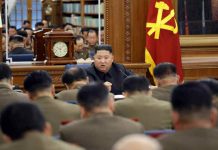There were eleven North Korean officials in Kim Jong Il’s party for his furtive visit to China over the five days between August 26th and 30th.
A report released yesterday by Chosun Central News Agency (KCNA) specified the eleven and their positions as Vice-Chairman of the National Defense Commission and Director of the Ministry of the People’s Armed Forces Kim Young Choon, Party Secretaries Kim Ki Nam, Jang Sung Taek, Hong Seok Hyeong, Kim Young Il, Kim Yang Gun, and Tae Jong Su, Chief Secretary of North Hwanghae Province Choi Ryong Hae, North Pyongan Province Kim Pyong Hae and Jakang Province Park Do Chun, and finally First Vice Foreign Minister of the North Korean Ministry of Foreign Affairs Kang Suk Ju.
The most noteworthy figure is certainly NDC Vice-Chairman Jang Sung Taek, who is said to be leading the Kim Jong Eun succession system, even though he was merely named as the director of a department of the Party in the KCNA report.
Jang was appointed Vice-Chairman of the National Defense Commission immediately after accompanying Kim on his previous visit to China in May. Jang holds a number of key positions in the military as well as the Party, along with being Kim Jong Il’s brother in law.
Given the fact that Kim Kyung Hee, Jang’s wife and Kim Jong Il’s sister, is the incumbent Director of the Ministry of Light Industry, this husband and wife team are the only Kim family members in a good position to support the Kim Jong Eun succession, and are two of the prominent executive officials responsible for carrying forward the creation of a strong and prosperous state by 2012, the centenary of Kim Il Sung’s birth.
Therefore, Kim may have chosen to take Jang to China in order to relieve the anxiety the Chinese feel over the Kim Jong Eun succession, and also demonstrate the stability of the North Korean domestic system.
Kim Young Choon, who is relatively well-versed in Chinese affairs among North Korean military officials, has now accompanied Kim Jong Il on five of his six visits to China. His attendance also may have been to emphasize the close relationship between the military authorities of the two countries since the North Korea-China alliance is one based fundamentally on military ties. It should be noted, though, that in the Chinese group there were no military figures.
Kang Suk Ju, who is in charge of both diplomatic activities with the U.S. and the Six-Party Talks, has also now taken part in five of Kim Jong Il’s visits to China. Since Kim’s visit to China comes during tough times for the Six-Party Talks, but at a time when China is making a real effort to get the Talks resumed, his administrative role may have been to negotiate the resumption of the Six-Party Talks with China, though that does not mean that resumption is impending.
Tae Jong Su and Hong Seok Hyeong are administrative figures involved in economic cooperation with China, and they are likely to have pursued discussion with the Chinese authorities on propelling forward the opening of the Rasun region as a part of the Chinese-led project, “Changchun-Jilin-Tumen Advanced Development Zone.”




















